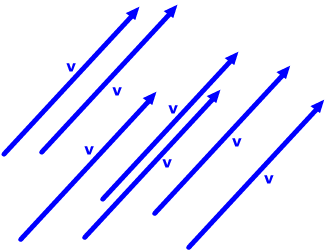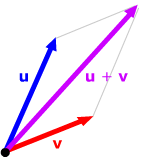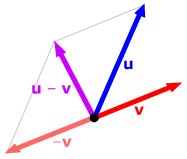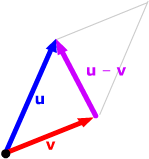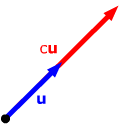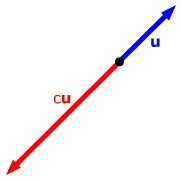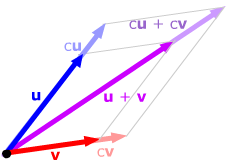Vector geometry
|
The basic idea: represent vector quantities by arrows. More specifically,
represent the size of the quantity by the length of the arrow and its
direction by the direction of the arrow. Represent the velocity of an
object moving 4 km/sec west by an arrow of length 4 pointing left, for
example.
|
|
|
If a vector starts at point P (its tail)
and ends at point Q (its head),
we'll denote it by PQ, or else just by
a single bold lower case letter like u
or v. |
|
|
An arrow should represent only the size and direction of the quantity;
it doesn't matter just where its head and tail are drawn as long as it
has the appropriate length and direction. In particular, arrows with the
same length and same direction are considered to be equivalent representations
of the same vector. (This is useful when it comes to solving problems;
you can draw your arrow wherever in your diagram works best.)
|
|
There are two ways to add vectors: the parallelogram rule and the "head-to-tail"
or triangle rule.
| Vector addition |
Parallelogram rule:
Represent both vectors by arrows with the same tail. Form a
parallelogram with the vectors as adjacent sides; then their
sum has their common tail as its tail point and the fourth vertex
of the parallelogram as its head.
|
|
|
Triangle rule.
Represent the second vector by an arrow with its tail at the
head of the first vector. Their sum will have the same tail
as the first vector and the same head as the second.
|
|
|
|
The two rules give the same sum, since the
triangle of the second form is just half the parallelogram of the first
form.
|
Using these rules over and over, it's possible to add many vectors together.
If your vectors represented displacements on a computer screen, for example,
such a sum could represent the final displacement of an object that moved 400
pixels down, 300 pixels left, and 500 pixels up.
It's possible that you end up back where you started; in that case the displacement
is represented by a point.
The zero vector 0
is a vector with length 0, and is represented by a single point. Its
direction can be assumed to be any direction that makes sense for the
problem under consideration.
|
You'd get a zero vector by adding to one vector a vector of the same length
but the opposite direction, for example.
The negative of
a vector v is the vector –v
with the same length as v but in
the diametrically opposite direction.
v + (–v)
= 0.
|
|
|
To subtract one
vector from another, add its negative :
u – v
= u + (–v).
|
|
|
Alternately, the difference of two vectors is the vector whose
tail is the head of the second and whose head is the head of the
first. (The parallelogram is congruent to the one above.)
|
|
|
Vectors can also be "scaled", or multiplied by scalars.
| Scalar multiplication |
Suppose u is
a vector and c is a scalar.
|
If c = 0 or u = 0,
then cu is the zero vector.
|
If c > 0 and u ≠
0, then cu
is the vector in the same direction as u
with a length c times the length of u.
|
|
|
If c < 0 and u ≠
0, then cu
is the vector in the direction diametrically opposite that of
u and with length (–c)
times the length of u.
|
|
|
Geometric vectors obey the same list of ten essential rules we had for matrices.
| Ten Essential Rules for Geometric Vectors
|
|
Closure rules:
for geometric vectors u and v
and any scalar c, |
u + v
is a geometric vector
|
cu is a geometric vector
|
|
Arithmetic rules for addition:
for any geometric vectors u, v
and w, |
u + v
= v + u
|
u + (v
+ w) = (u
+ v) + w
|
There is a vector 0 such that u
+ 0 = 0
+ u = u
for all geometric vectors u.
|
For each geometric vector u, there
is a geometric vector –u such
that u + (–u)
= 0.
|
|
Arithmetic rules for scalar multiplication:
for any geometric vectors u and v
and any scalars c and d, |
c(u + v)
= cu + cv
|
(c + d)u = cu
+ du
|
(cd)u = c(du)
|
1u = u
|
Some of these rules are obvious from the definitions.
For example, the commutative rule u
+ v = v
+ u is clear from the parallelogram
method of addition, since it doesn't matter which of the two vectors
you write first. |
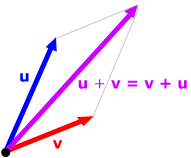 |
|
The associative rule u
+ (v + w)
= (u + v)
+ w for addition follows from the
head-to-tail method of addition, since the result of either side
is just a vector with the tail of the first vector and the head
of the last. |
|
|
| Other rules can be proved using basic geometry;
for example, the distributive rule c(u
+ v) = cu
+ cv can be proved using similar
triangles. (For c > 0 as in the diagram, prove that cu
+ cv is parallel to u
+ v and has length c times the
length of u + v.) |
|
|
For the other distributive rule, (c + d)u
= cu + du,
compare the lengths of cu, du
and (c + d)u for c and d with all possible
signs.
|
![]()

